|
|
|
Sort Order |
|
|
|
Items / Page
|
|
|
|
|
|
|
| Srl | Item |
| 1 |
ID:
014298


|
|
|
|
|
| Publication |
Feb 1992.
|
| Description |
71-84
|
|
|
|
|
|
|
|
|
|
|
|
|
|
|
|
| 2 |
ID:
163191
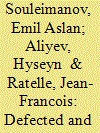

|
|
|
|
|
| Summary/Abstract |
Can former insurgents in the service of counterinsurgent paramilitaries be considered a perfectly loyal force? What mechanisms may help to deter subsequent defections of individuals who have already “betrayed” once? Drawing on a unique set of primary data, this article examines the effective counter-defection practices of Chechnya’s pro-Moscow paramilitaries toward prospective defectors from among ex-insurgents. It explores three interwoven mechanisms employed with various intensities to avert “double defections” at the peak of the locally fought counterinsurgency in Chechnya from 2000 to 2005. These mechanisms are: a) extrajudicial executions of recidivists and their relatives, b) initiation violence targeting insurgents’ relatives, and c) disclosure of the identities of defected insurgents who were responsible for killing insurgents in combat to the families of slain insurgents.
|
|
|
|
|
|
|
|
|
|
|
|
|
|
|
|
| 3 |
ID:
152965


|
|
|
|
|
| Summary/Abstract |
In the recent era of state formation in Afghanistan, hundreds of small popular movements rebelled against the Taliban throughout the country. One in particular stands out – the Andar Uprising in the spring of 2012 gave a compelling case of local vigilantism in an area ripe with historic grievances and narratives of community defense dating back to the anti-Soviet jihad. This case is compelling as it shows one faction of the movement engaging in protective paramilitary behavior over the civilian population, while the other faction engages in predatory behavior. Controlling processes, incentives structures, and narratives were all factors correlating to the rise of a popular anti-Taliban resistance in Andar District that battled the Taliban and perceived oppression in their district. When patrons and the community engaged in complementary governance over the paramilitary group, in this case through the Afghan Local Police (ALP), paramilitary behavior was protective of the civilian population. However, when patrons and communities failed to provide complementary governance, as the case of the remaining Uprising force after ALP institutionalization, the paramilitaries engaged in predation on the local population.
|
|
|
|
|
|
|
|
|
|
|
|
|
|
|
|
| 4 |
ID:
190007
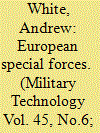

|
|
|
| 5 |
ID:
106855


|
|
|
|
|
| Publication |
2011.
|
| Summary/Abstract |
This article considers in detail loyalist paramilitary activity in Northern Ireland since the paramilitary cease-fires of 1994. The continuing nature of contemporary loyalist violence is documented with reference to sectarian attacks against members of the "Other"/Catholic community and associated symbols of that community, violence directed at other loyalists, and the potential for future violence given constitutional uncertainty regarding Northern Ireland's position within the United Kingdom. The article also challenges assumptions within the broader literature of an inability within loyalist paramilitary groups to move beyond violence in the post-cease-fire period with particular reference to their conflict transformation efforts.
|
|
|
|
|
|
|
|
|
|
|
|
|
|
|
|
| 6 |
ID:
101268
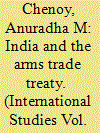

|
|
|
|
|
| Publication |
2010.
|
| Summary/Abstract |
The Arms Trade Treaty (ATT) seeks to regulate the transfer of conventional arms on the principle that arms exporters and importers have a responsibility to ensure that weapons are not used in violations of international law. India wants the ATT to be limited to illicit trade. It believes that the United Nations has various mechanisms to deal with human rights violations and that this issue should not be linked to arms trade. Indian citizens have spoken against gun vio-lence. Whether it is against the guns that killed Jessica Lall in Delhi or people in the conflict zones of Manipur, Kashmir or the Maoist-affected regions, Indians are fighting against the menace of the gun culture. The ATT is a just cause and India needs to support it.
|
|
|
|
|
|
|
|
|
|
|
|
|
|
|
|
| 7 |
ID:
091489
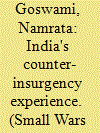

|
|
|
|
|
| Publication |
2009.
|
| Summary/Abstract |
The Indian Army, a force trained primarily for conventional warfare, has been engaged in internal counter-insurgency operations since the 1950s. Despite such a long innings on a counter-insurgency mode, little attention has been accorded within military circles to doctrinal innovation for waging sub-conventional warfare in India's democratic political context. At best, the Army continues to view counter-insurgency duty as secondary to its primary duty of defending India from external conventional threats. By conceptualizing a counter-insurgency strategy of 'trust and nurture', this article aims to fill this critical doctrinal gap in India's military policy. The author argues that a counter-insurgency strategy of 'trust and nurture' based on democratic political culture, measured military methods, special counter-insurgency forces, local social and cultural awareness and an integrative nation-building approach will result in positive handling of India's internal security problems. The author utilizes India's counter-insurgency experiences in Assam, Mizoram, Nagaland, Punjab, and Operation 'Sadhbhavana' in Jammu and Kashmir as illustrative empirical indicants in order to validate the 'trust and nurture' strategy.
|
|
|
|
|
|
|
|
|
|
|
|
|
|
|
|
| 8 |
ID:
166167
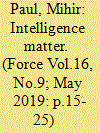

|
|
|
| 9 |
ID:
178688
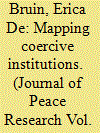

|
|
|
|
|
| Summary/Abstract |
How rulers organize and use their security forces is thought to have important implications for regime survival, repression, and military effectiveness. While a number of studies provide insight into the coercive institutions of individual states, efforts to understand systematic patterns have been hampered by a lack of reliable data on state security forces that can be compared across states and within them over time. This article presents the State Security Forces (SSF) dataset, which includes 375 security forces in 110 countries, 1960–2010. It tracks how each force is commanded, staffed, equipped, and deployed, as well as the number of security forces and potential counterweights in each state’s security sector as a whole. After illustrating how the SSF dataset differs from related ones and presenting descriptive trends, the article shows how it can be used to deepen our understanding of coup-proofing and strategic substitution, and identifies additional research uses of the dataset.
|
|
|
|
|
|
|
|
|
|
|
|
|
|
|
|
| 10 |
ID:
094140


|
|
|
|
|
| Publication |
2010.
|
| Summary/Abstract |
This article addresses the causes and dynamics of spin-off violence by paramilitary groups that developed in Serbia in the early 1990s. It shows that some forms of violence that challenge the state's monopoly come into being due to decisions of state agencies. But delegated violence easily develops a life of its own, and therefore the decisions of state leaders are not the only variable, perhaps not even an important one, needed to explain the dynamics of violence once the turmoil of war has started. In retrospect, it seems as if warfare was just an episode in the political life of militias or the political groupings behind them. Violence was just one means among others in the fight for political chances. Therefore, the emergence and the life of these groups have to be explained as attempts of single political entrepreneurs to achieve the accumulation of power through the exertion of violence
|
|
|
|
|
|
|
|
|
|
|
|
|
|
|
|
| 11 |
ID:
176310


|
|
|
| 12 |
ID:
109540


|
|
|
| 13 |
ID:
141833


|
|
|
| 14 |
ID:
157454


|
|
|
| 15 |
ID:
149481


|
|
|
|
|
| Summary/Abstract |
This article challenges the well-established presentation within conflict studies of paramilitary organizations as state-manipulated death squads or self-defence groups, and argues that some present-day militias extend their functions well beyond the role of shadowy pro-regime enforcers. Drawing its empirical insights from Ukrainian pro-government volunteer battalions and supporting its findings with empirical observations from other parts of the world, the article posits that the rise of powerful militia organizations acting in parallel with the state makes it imperative to revisit the theory and typology of paramilitary violence. The key theoretical argument of the article is that ‘state-parallel’ militias differ qualitatively from the ‘state-manipulated’ paramilitaries that are typical of the Cold War period. The article shows that although ‘state-parallel’ paramilitaries are not a new phenomenon, they have thus far remained critically understudied and undertheorized.
|
|
|
|
|
|
|
|
|
|
|
|
|
|
|
|
| 16 |
ID:
188339
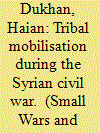

|
|
|
|
|
| Summary/Abstract |
As a result of the debilitating situation that the Syrian state reached during the Syrian Civil War, the government relies heavily on paramilitary groups to confront security challenges. Existing studies imply that all the paramilitary groups in Syria were formed in a largely top-down process. Focusing on the rise of al-Baqqer Brigade in Syria and relying on a series of in-depth interviews with members of the al-Baggara tribe who make up most of this militia, this paper challenges that assumption. The paper shows that the emergence of tribal militias is principally a grassroots phenomenon stemming from competition over local resources. It argues that the Syrian state has seized this opportunity and outsourced some of its security and counterinsurgency tasks to the group.
|
|
|
|
|
|
|
|
|
|
|
|
|
|
|
|
| 17 |
ID:
165186


|
|
|
|
|
| Summary/Abstract |
The American way of war in Afghanistan presents a conundrum for proponents of 21st-century state-building projects. How can liberal peace proponents engage in efficient state building without sacrificing their ideals? The US learned that state-building allocates a degree of command and control to powerbrokers operating in the shadows to launder aid money, traffic illicit narcotics, and engage in extrajudicial punishments. These clients failed to represent the liberal values foreign patrons endorsed, because the latter not only offered resources without conditions but also rewarded bad behavior. This issue is examined by looking at the case of post-2001 northern Afghanistan, where powerful warlords should have held greater control over their paramilitary forces, limited predatory behavior, and built stronger relationships with the community. Instead, warlords-turned-statesmen expanded their material and social influence in the north, while holding onto the informal instruments of racketeering and patronage that overwhelmed Western ideals and shaped the predatory state present in Afghanistan today. Moreover, paramilitaries were influenced by material, social, and normative incentives that rewarded violent and predatory behavior and further eroded already weak community control mechanisms at the subdistrict level.
|
|
|
|
|
|
|
|
|
|
|
|
|
|
|
|
|
|
|
|
|